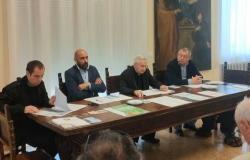«When in the future we are separated / the music will show you my heart». The words of Paul McCartney’s oratory are sweet and poignant Ecce Cor Meum (Behold my heart) dedicated to his beloved wife Linda who passed away in 1998. The baronet was writing an oratorio in four movements for orchestra, soloists and youth, adult and children’s choir, commissioned by Magdalene College, Oxford to inaugurate the new hall concert when Linda died causing the opera to suddenly stop. «I had to take a year off just to cry and then I picked up the job again – Sir McCartney revealed in various interviews at the time -. There’s an interlude in the middle of Ecce Cor Meum, which is a very sad piece of music and I remember sitting at the keyboard, crying while I was playing it. It happens to me every time.”
An oratory partly in Latin and partly in English which took eight years of study and work and takes inspiration from the cult of the Sacred Heart of Jesus and from a statue of Christ in the New York church of Sant’Ignazio di Loyola, at whose foot the inscription stands from which the work takes its name. Ecce Cor Meum debuted only in 2001 and became an album in 2006, produced and orchestrated by John Fraser and awarded best album at the 2007 Classical Brits. It was successfully performed at the Royal Albert Hall in London and at Carnegie Hall in New York, but in However, this fourth composition of classical music by Paul McCartney never arrived in Italy.
It is therefore a highly anticipated Italian premiere of Ecce Cor Meum, on stage on Wednesday 24 April at 8pm at the Teatro Comunale of Ferrara. This is a new production by the Fondazione Teatro Comunale di Ferrara, in collaboration with the Beatlesiani d’Italia association, performed by the soprano Melissa Purnell and the City of Ferrara Orchestra directed by Lorenzo Bizzarri, the Quadriclavio Choir and the White Voices Choir. The little musicians” with musical arrangements by Antonio Aiello and Cristina Zavalloni, who will also be the voice that will continue the evening with Beatles greatest hits.
After Liverpool Oratory (1991), Standing stone (1997) and the chamber music of Working classical (1999) the former Beatles returns to deal with art music. «McCartney – states Rolando Giambelli, president of the Italian Beatles Association – is a musical genius. As a child he sang in the cathedral choir in Liverpool and studied Latin Ecce Cor Meum he wanted to make these universes similar to him communicate.” Giambelli has now managed to bring the opera to Italy thanks to the opening of the Teatro Comunale di Ferrara and its artistic director Marcello Corvino who claims: «I don’t think this project goes outside the canons of classicism. The music of the 20th century is Bob Dylan, the Beatles, Queen, the Rolling Stones. And so there is nothing strange in our programming if they are there Turandot by Puccini and McCartney’s oratorio. There is a lot that comes from the past in the Beatles’ songs, we often find the harpsichord and Renaissance polyphonies. The English have always had a keen eye on their past, even in the most revolutionary moments they hold firm roots. Oratorio is to English music what opera is to Italian music.”
Maestro Corvino also announced that he will play the violin together with the orchestra in Ecce Cor Meum : «There are triple figurations that remind me a lot of baroque opera. Musically it has ancient roots but also obviously the eyes of Paul McCartney. The score is complex in some cases, despite being fluent. It seems easy but when you play it you realize the technique. Masterpieces are like this.”
McCartney’s work is also a hymn to peace, “peace and love are always our true nature” he repeats in the final Ecce. On Classical Radio FM Sir McCartney, who di Ecce Cor Meum he also made the motto of his noble coat of arms, he explained at the time: «I wasn’t looking for something that was specifically Christian, but John Taverner had asked me to narrate one of his pieces based on the Greek poet Cavafy. I went to New York to a very ornate and beautiful church. Looking around the church I saw a statue of the crucifixion on the wall and underneath I saw “Ecce Cor Meum”. So I searched my mind for some Latin I studied in school. So I understood that it was “here is my heart” and from there the idea for the text was born.”
The soloist’s interventions alternate with large choral sections and evocative instrumental interludes, looking to the tradition of seventeenth-century Latin oratorio. Ecce Cor Meum it is a tender elegy that the author dedicates to the memory of his first wife, with suggestions derived from the Scriptures, but expressed in a non-denominational way. A moment of meditation is followed by renewed confidence in the future thanks to the power of love. Spiritus it is a heartfelt invocation to a spiritual entity with multiple declinations, to guide humanity along the path of love without which it would be lost. In Gratia the devotional element is once again declined in a secular context, where the state of serenity arises from hope. The instrumental interlude Lament it is the pinnacle of the work’s emotional resonance, with a melancholic oboe melody moving over the choir’s hushed vocalizations. In Music we celebrate the art that brings joy and leads to the discovery of wisdom, but also of love and self-awareness. With Ecce the author bids farewell to the public with a celebration of love, capable of surviving separation and death; if the foundations of love are solid, everyone is able to face any adversity, even when they feel they can’t make it and everything seems lost.
Tags: McCartney oratorio Linda arrives Italy





